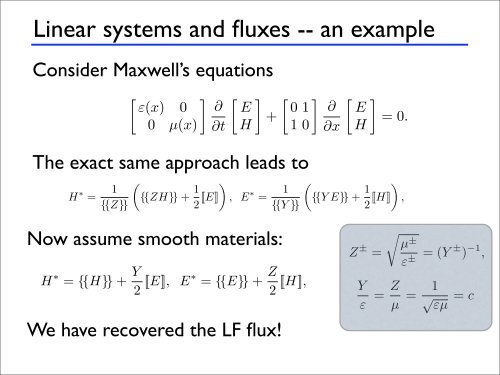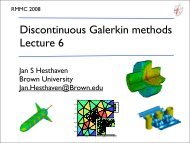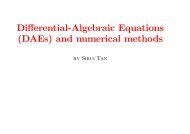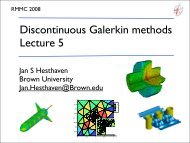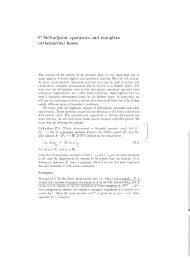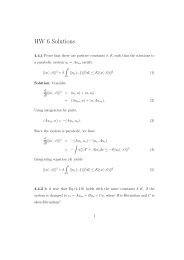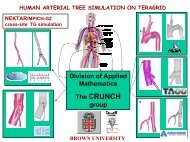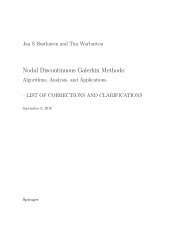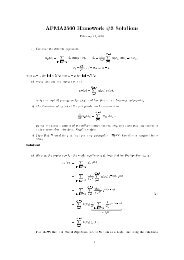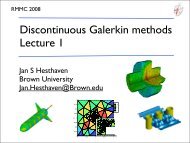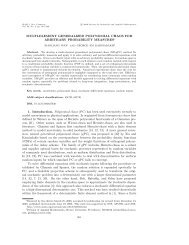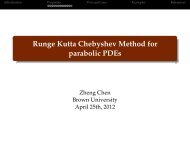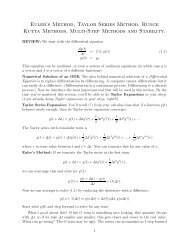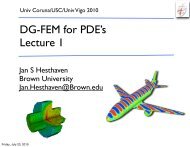Discontinuous Galerkin methods Lecture 3 - Brown University
Discontinuous Galerkin methods Lecture 3 - Brown University
Discontinuous Galerkin methods Lecture 3 - Brown University
You also want an ePaper? Increase the reach of your titles
YUMPU automatically turns print PDFs into web optimized ePapers that Google loves.
Let us also consider a slightly more complicated problem, originating<br />
Linear systems and fluxes -- an example<br />
electromagnetics.<br />
2.5 Exercises 39<br />
Example Consider 2.6. Consider Maxwell’s the equations<br />
one-dimensional Maxwell’s equations<br />
<br />
1<br />
ε(x) 0 ∂ E 01 ∂ E<br />
{{ZH}} + +<br />
=0. (2.2<br />
{{Z}}<br />
0 µ(x) ∂t H 10 ∂x H<br />
1<br />
2 [[E]]<br />
<br />
, E ∗ = 1<br />
<br />
{{YE}} +<br />
{{Y }}<br />
1<br />
2 [[H]]<br />
or<br />
H<br />
<br />
,<br />
∗ = 1<br />
<br />
{{ZH}} +<br />
{{Z}}<br />
1<br />
2 [[E]]<br />
<br />
, E ∗ = 1<br />
<br />
{{Y }}<br />
where<br />
Z ± <br />
µ ±<br />
=<br />
ε ± =(Y ± ) −1 ,<br />
2.5 Exercises 39<br />
Here (E, H) = (E(x, t),H(x, t)) represent the electric and magnetic fiel<br />
respectively, while ε and µ are the electric and magnetic material propertie<br />
known as permittivity and permeability, respectively.<br />
To simplify the notation, let us write this as<br />
Q ∂q<br />
+ A∂q<br />
∂t ∂x =0,<br />
or<br />
H<br />
where<br />
<br />
ε(x) 0<br />
01 E<br />
Q =<br />
, A = , q = ,<br />
0 µ(x) 10 H<br />
reflect the spatially varying material coefficients, the one-dimensional rotatio<br />
operator, and the vector of state variables, respectively.<br />
∗ = 1<br />
<br />
{{ZH}} +<br />
{{Z}}<br />
1<br />
2 [[E]]<br />
<br />
, E ∗ = 1<br />
<br />
{{YE}} +<br />
{{Y }}<br />
1<br />
2 [[H]]<br />
<br />
,<br />
where<br />
Z ± <br />
µ ±<br />
=<br />
ε ± =(Y ± ) −1 ,<br />
represents the impedance of the medium.<br />
If we again consider the simplest case of a continuous medium, things<br />
simplify considerably as<br />
H ∗ = {{H}} + Y<br />
2 [[E]], E∗ = {{E}} + Z<br />
2 [[H]],<br />
or<br />
H<br />
which we recognize as the Lax-Friedrichs flux since<br />
∗ = 1<br />
<br />
{{ZH}} +<br />
{{Z}}<br />
1<br />
2 [[E]]<br />
<br />
, E ∗ = 1<br />
<br />
{{Y }}<br />
where<br />
Z ± <br />
µ ±<br />
=<br />
ε ± =(Y ± ) −1 ,<br />
represents the impedance of the medium.<br />
If we again consider the simplest case of a cont<br />
simplify considerably as<br />
H ∗ = {{H}} + Y<br />
2 [[E]], E∗ Z<br />
= {{E}} +<br />
± <br />
µ ±<br />
=<br />
ε ± =(Y ± ) −1 ,<br />
the impedance of the medium.<br />
again consider the simplest case of a continuous medium, things<br />
onsiderably as<br />
H ∗ = {{H}} + Y<br />
2 [[E]], E∗ = {{E}} + Z<br />
2 [[H]],<br />
recognize as the Lax-Friedrichs flux since<br />
Y Z<br />
=<br />
ε µ = 1<br />
represents the impedance of the medium.<br />
If we again consider the simplest case of a cont<br />
simplify considerably as<br />
H<br />
√ = c<br />
εµ ∗ = {{H}} + Y<br />
2 [[E]], E∗ = {{E}} +<br />
which we recognize as the Lax-Friedrichs flux since<br />
Y Z<br />
=<br />
ε µ = 1<br />
The exact same approach leads to<br />
Now assume smooth materials:<br />
√ = c<br />
εµ<br />
We have recovered isthe the LF speed flux!<br />
of light (i.e., the fastest wave speed in th<br />
−1 −1/2


